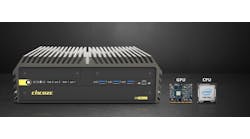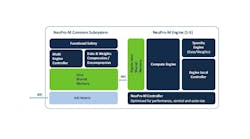Is a PLC smart? It's smart like a reptile, and it can reliably and robustly control the many things connected to it using its programmed functions. However, there are different levels of intelligence needed to keep automated machines, systems or critical parts operating. For smart machines, the PLC is just a type of machine intelligence. Several types of control need to communicate and combine to make a truly smart machine.
Much of these basics on smart machines were discussed by Peter J. Photos, Ph.D., chief scientist and executive vice president at Streamline Innovations at the 2019 Ignition Community Conference in Folsom, California. Photos discussed several smart communication methods and types of smart control during his breakout session about building intelligent systems of the future.
A typical system starts with the machine or process controlled by a PLC with a human-machine interface (HMI), but a smarter machine may remove the HMI and replace it with an Ethernet cable and supervisory control and data acquisition system (SCADA). The HMI becomes a client of the SCADA system viewed on a smartphone. It may also eliminate the thousands of wires entering a control room and replace it with an Ethernet cable. Smart machines are also monitored and controlled remotely reducing the need to visit a site.
“Smarter” means easy connection to the cloud, and building a server and sending data to the cloud adds intelligence. There are many cloud services out there, and some bit-size cloud-services options are scalable such as DigitalOcean. These services can make deploying, managing and scaling cloud infrastructure and applications easier.
These smart machines should present the data neatly, organized and ready for use by a data scientist or modeling software. Smart machines now and in the future will require a model and analytics that predict real-time and future operation. The system should also monitor the data and provide a text message or email warning, for example, when needed.
So what is a smart machine, or, more simply, what is smart? "Making machines smart is similar to how humans are smart, in theory," says Photos. "Build a pump skid, install a Moxa PC, install Ignition Edge for an edge-of-network HMI with Web and data functionality, and it's smart. Then develop a screen quickly, add a control program and use off-the-shelf parts and it's smart and cost-effective."
From a conceptual standpoint, some theories discuss four major areas of your brain; the amygdala, reptilian brain, limbic system and neocortex. The amygdala is the oldest part of the brain—the lizard brain. It's designed to keep you alive with food, fight and flight type reactions. It's an alarm system that gets you out of danger with its fast evaluation and response system to keep the person safe, but it may not always be accurate without additional analysis.
The reptilian brain is your primitive part that keeps you alive as well. The primitive brain is responsible for the most basic survival functions such as heart rate and breathing and orientation in space. It has very consistent control mechanisms and has priority over other systems of the brain. You have little or no control over your heart rate and rarely is it necessary to think about or control your breathing.
Another more complex part of the brain is the limbic system or mammalian brain. It controls emotions and communication to your limbs so all parts of the human are in communication to your brain.
A final part is the neocortex or the smart brain—the part that makes you human. It provides the high order conscious activities including language, abstract thought, creativity, solve equations, analyze trends and think outside the box.
"Why not structure our control systems in plants using the same analogy," asks Photos. "There are some significant comparisons. The amygdala keeping you alive and out of danger is an emergency-stop safety circuit. The reptilian brain performing second-to-second tasks keeping your heart and breathing correct is the reliable PLC. The limbic system communicating to all the parts and ensuring relevant areas stay in touch is the SCADA software such as Ignition. And finally, the neocortex is where we can have fun and get really smart. It’s a high-level, general-purpose programming language such as Python."
For smart machines, think about what part of the brain is to do what and when. "It can speed the development of control systems for machines and processes," says Photos. "It's brains vs. brawn. The PLC is great at handing huge amounts of I/O and can easily communicate and control it, but it's not the sharpest knife in the drawer. But you don't need that if you have a computer next to it. Put the brain in a computer next to the PLC and let it do the advanced calculations. It is easy to get a cheap computer to do it. And there are other advantages to that. Keeping the advanced calculations separate can free up memory and CPU time and keep the PLC from crashing. The neocortex can shut down while you sleep, and the reptilian brain keeps things operating. In other words, the Python or similar software and the PLC can operate semi-independently, but there is still plenty of control."






